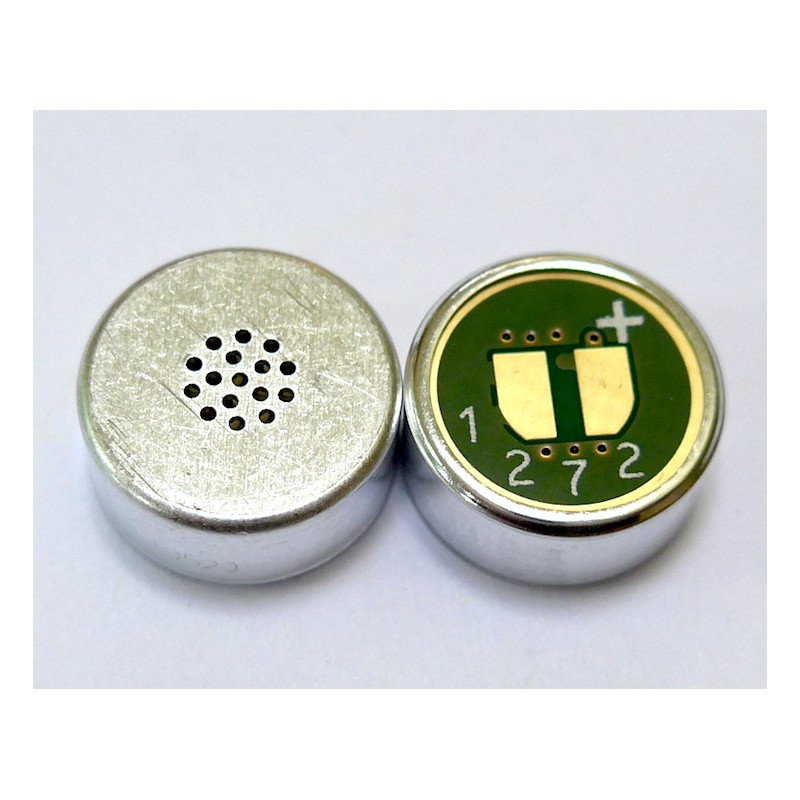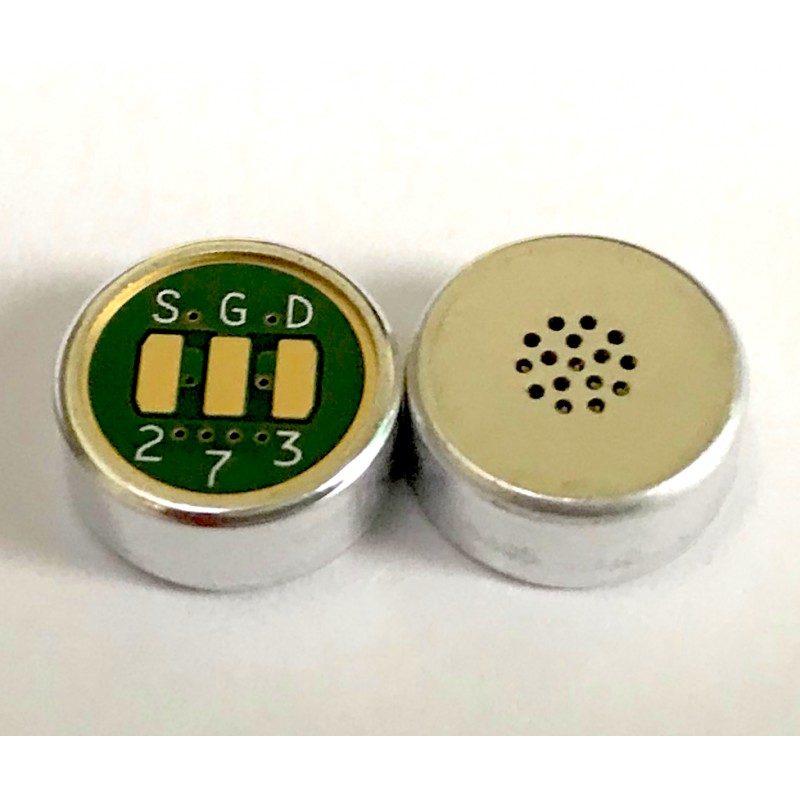I think it would be. 
But if TNT wants to build the whole dish of pasta, then starting with a Primo capsule and adapting it to run into an ADC is going to be the recipe. Find a couple of good ADCs (already mentioned) and study the datasheets to learn what they want in the way of a signal. The ADCs I've worked with wanted a low impedance differential signal. They also have a DC bias at the inputs.
Then there is the chore of taking the ADC output and getting to the recorder.
But if TNT wants to build the whole dish of pasta, then starting with a Primo capsule and adapting it to run into an ADC is going to be the recipe. Find a couple of good ADCs (already mentioned) and study the datasheets to learn what they want in the way of a signal. The ADCs I've worked with wanted a low impedance differential signal. They also have a DC bias at the inputs.
Then there is the chore of taking the ADC output and getting to the recorder.
What is a digital microphone? A professional microphone with built-in fixed-gain preamplifier, ADC and AES3 interface, that is, almost exactly what TNT wants?
I know there are microphone capsules with built-in single-bit sigma-delta modulator, but the ones I know of are consumer grade things.
I know there are microphone capsules with built-in single-bit sigma-delta modulator, but the ones I know of are consumer grade things.
Last edited:
Would it not be easier to start with a digital microphone ?
That would be the end
//
Looks like it. 14 dB(A) noise and 135 dB maximum sound pressure level, although it is unclear at what distortion level, so 121 dB(A) dynamic range. For some reason Primo EM273 Microphone Capsule - micbooster.com claims a dynamic range of only 108 dB.
The 272-Z1 is claimed to be identical to 273 except for a built in resistor but picture show they are not identical - the solder side has 7 little holes while the other has 8 (273) in a different distribution pattern.


Maybe 272 Z1 could be good in order to be able to set this resistor when optimising the gain structure...
http://www.primomic.de/pdf/EM272Z1.pdf
http://www.primomic.de/pdf/EM273.pdf
http://www.primomic.de/pdf/EM258.pdf
258 looks the more linear FR wise...
Scott: Shopping for a measurement mic | Page 3 | Audio Science Review (ASR) Forum
What is this bootstrapping?
//


Maybe 272 Z1 could be good in order to be able to set this resistor when optimising the gain structure...
http://www.primomic.de/pdf/EM272Z1.pdf
http://www.primomic.de/pdf/EM273.pdf
http://www.primomic.de/pdf/EM258.pdf
258 looks the more linear FR wise...
Scott: Shopping for a measurement mic | Page 3 | Audio Science Review (ASR) Forum
What is this bootstrapping?
//
Last edited:
Regarding that 135 dB SPL for the EM273, it must be close to hard clipping:
Supply voltage: 5 V
Sensitivity: -37 dB with respect to 1 V/Pa -> 14.125 mV/Pa
As the reference for sound pressure in air is 20 uPa, 135 dB SPL corresponds to 112.27 Pa RMS
Hence, there should be 1.5887 V RMS coming out of the capsule at 135 dB SPL
As everyone always assumes sine waves, that corresponds to 4.4934 V peak-peak, quite close to the 5 V supply
Supply voltage: 5 V
Sensitivity: -37 dB with respect to 1 V/Pa -> 14.125 mV/Pa
As the reference for sound pressure in air is 20 uPa, 135 dB SPL corresponds to 112.27 Pa RMS
Hence, there should be 1.5887 V RMS coming out of the capsule at 135 dB SPL
As everyone always assumes sine waves, that corresponds to 4.4934 V peak-peak, quite close to the 5 V supply
Both, I think, for the noise. Scott Wurcer wrote an interesting article about it in Linear Audio volume 1, but it's been a while since I read it.
Linear Audio | your tech audio resource
Linear Audio | your tech audio resource
I just placed an order at ti.com for a PCM4222 Evaluation Module (EVM).
I will also buy capsules. Just need to make the right choice...
I have a buddy who just got a 3D printer - I'll ask him to print 2 cases to house the capsules. Can one hope for lower Q resonances in plastic perhaps
Would there be any acoustic consideration of the shape of the tip/case wrt FR? I'm free to do anything now really Crazy (but good!) ideas??
Crazy (but good!) ideas??
//
I will also buy capsules. Just need to make the right choice...
I have a buddy who just got a 3D printer - I'll ask him to print 2 cases to house the capsules. Can one hope for lower Q resonances in plastic perhaps
Would there be any acoustic consideration of the shape of the tip/case wrt FR? I'm free to do anything now really
//
Is there a real physical/native sensitivity aspect in these capsules or is it all in the built in electronics? Max SPL? Noise? - Mechanics or electronics?
If electronics, it would be best to get one with as least electronics built in as possible!?
//
The small capsule mics are surprisingly close to being limited by basic physics. The noise scales roughly as the square root of the area of the diaphragm while the frequency response goes up with the smaller size.
The cheap capsules have a built in FET, do NOT think replacing it with something like an SK170 will lower the noise. A capsule like the WM-61 has about 10pF of capacitance and the input capacitance of the FET will form a voltage divider to the input signal (charge) eliminating any apparent noise benefits.
A mod that does work is the three wire connection (some of the Primo capsules come that way) which allows one to use the FET as a source follower instead of a common source amplifier, you give up the gain but get much more MAX spl. This is because as a common source amplifier the signal is directly connected across the gate/source junction which acts like a diode limiter. I have a circuit in my article where a fully bootstrapped three wire capsule can do 8.5V p-p from a 9V battery.
It should be possible to have a recorder without a gain control if you manage the noise floor correctly since the maximum headroom can be increased a lot with a little work.
Would there be any acoustic consideration of the shape of the tip/case wrt FR? I'm free to do anything now reallyCrazy (but good!) ideas??
//
Nothing special, the last few inches of the body should be the same diameter as the capsule and any buffer electronics can go in a wider part of the body below that. You might want to buffer any long cable lengths.
Many thanks - I will purchase that issue of Linear Audio. Was there ever anyone building boards or so?
So now with the above valuable feedback, I have my mind set to EM273 : https://primomic.com/pdf/EM273.pdf
All against? All for?
//
So now with the above valuable feedback, I have my mind set to EM273 : https://primomic.com/pdf/EM273.pdf
All against? All for?
//
Btw: here is my Jecklin rig at the location of the organ recording...
The USB sound-card is placed indicated by the red square. I will do something similar for this but smaller and closer to mics if possible. Most certain I will solder both ends of the mic cables so it must be integrated with a transport solution for protection but need to "fold" out to take positions for duty.
//
The USB sound-card is placed indicated by the red square. I will do something similar for this but smaller and closer to mics if possible. Most certain I will solder both ends of the mic cables so it must be integrated with a transport solution for protection but need to "fold" out to take positions for duty.
//
Attachments
- Home
- Source & Line
- Digital Line Level
- Fixed gain field recorder?
